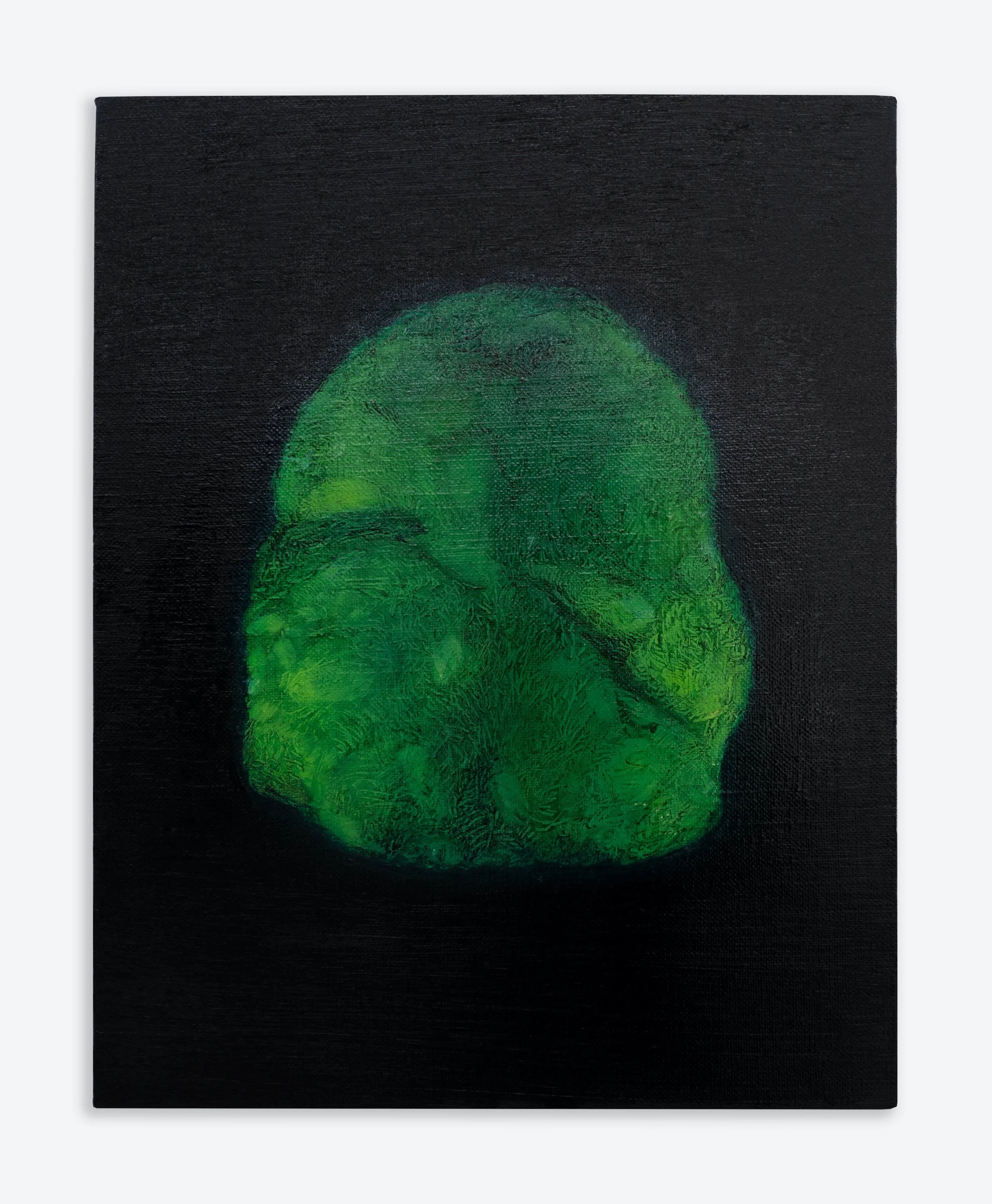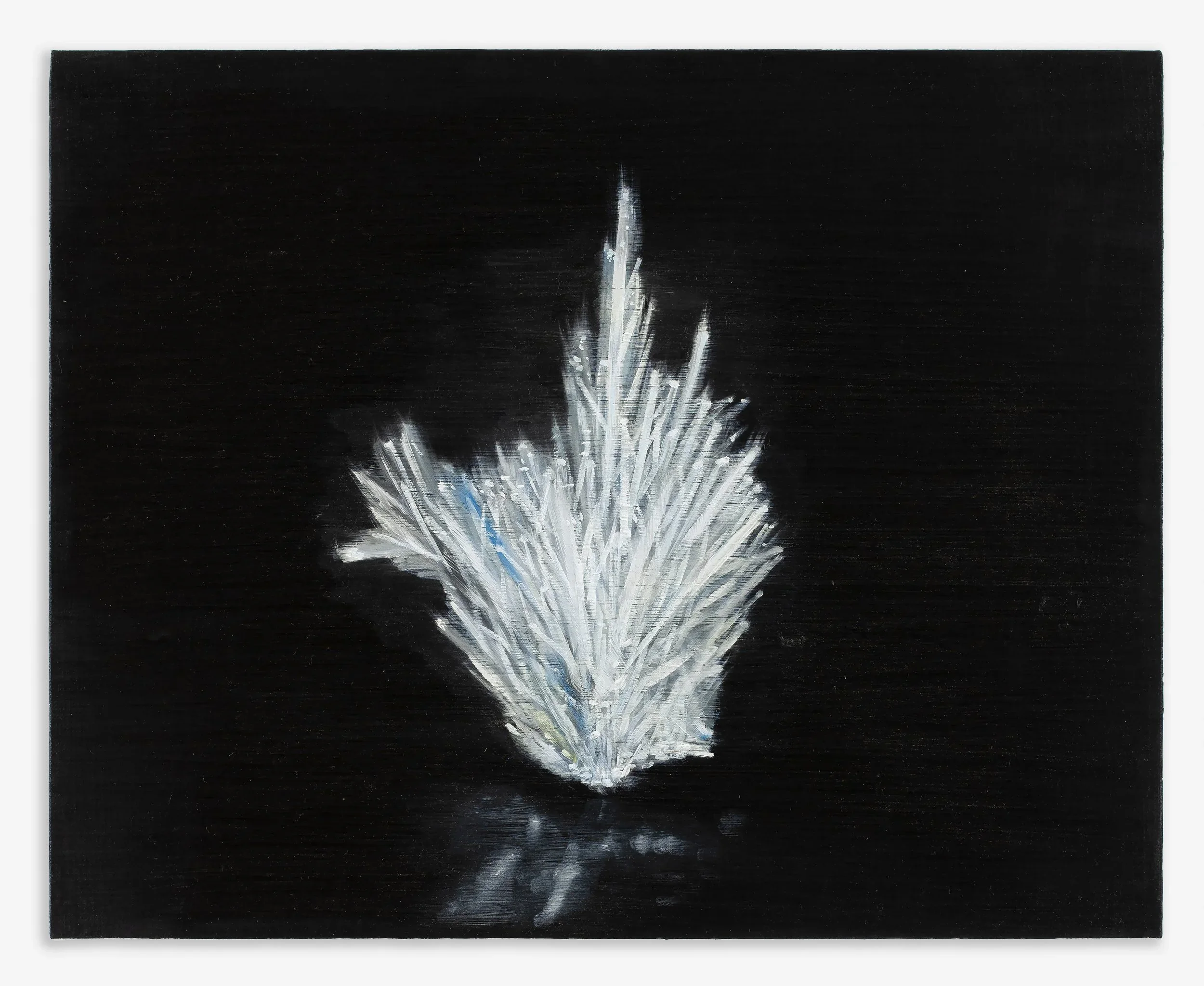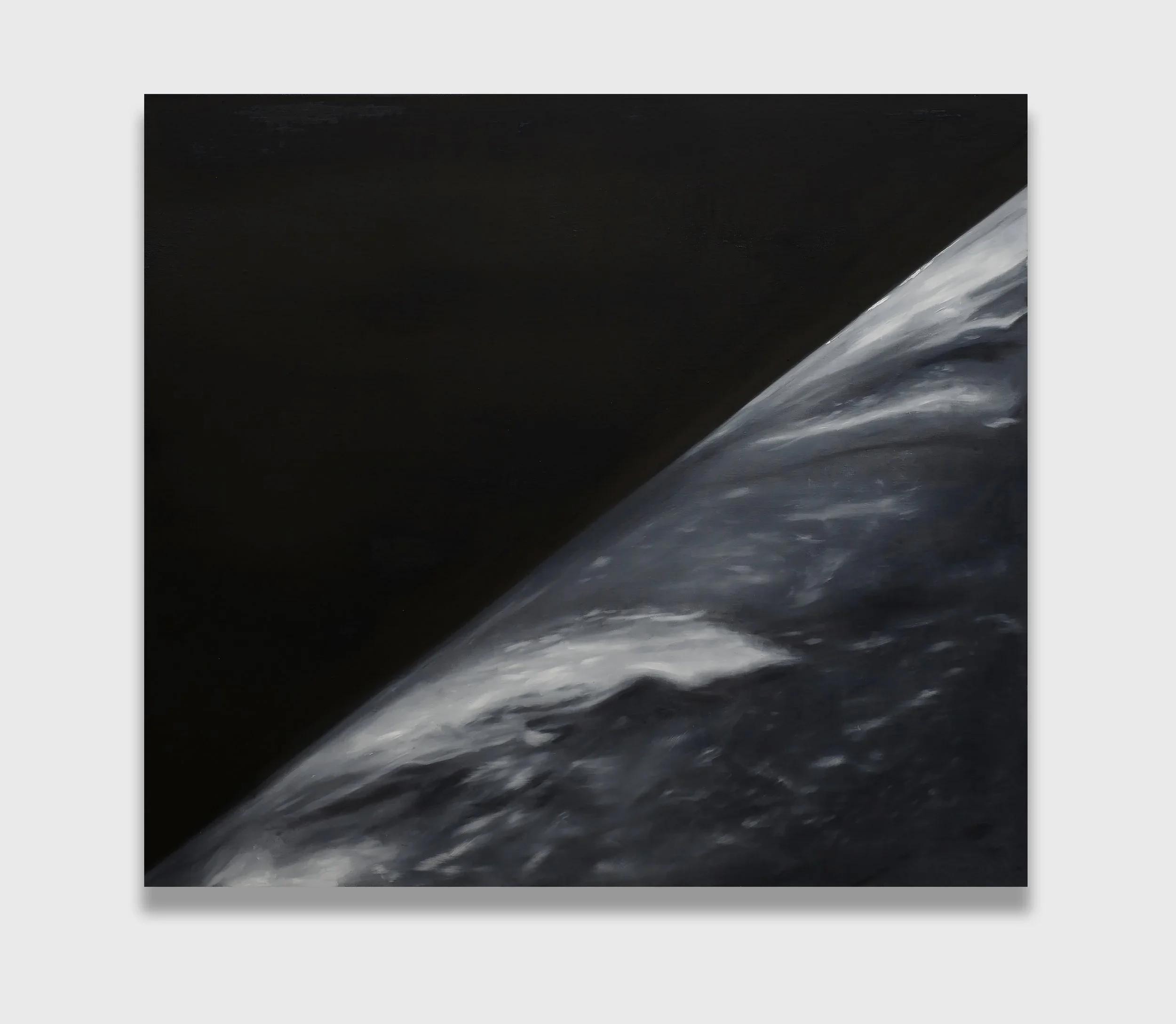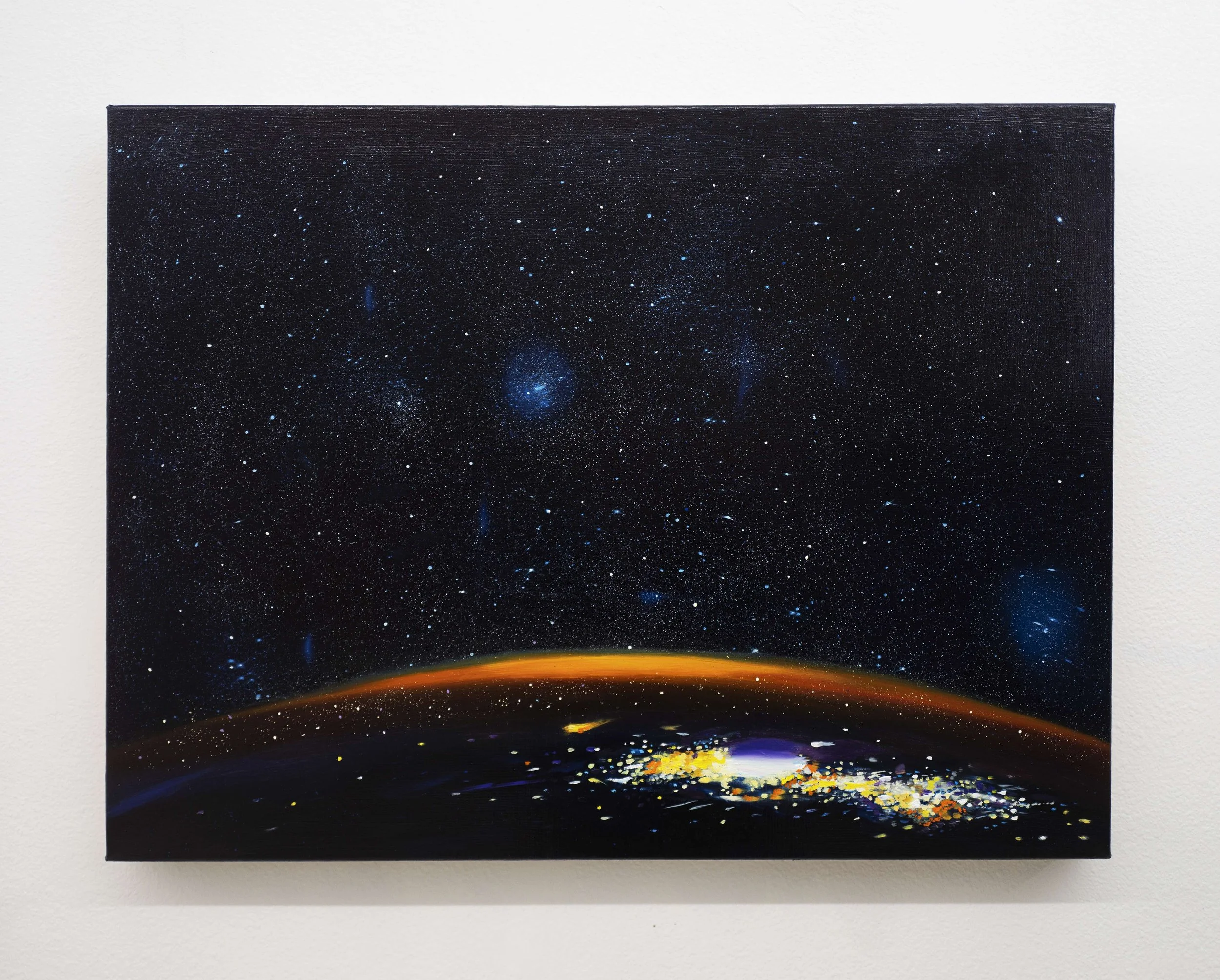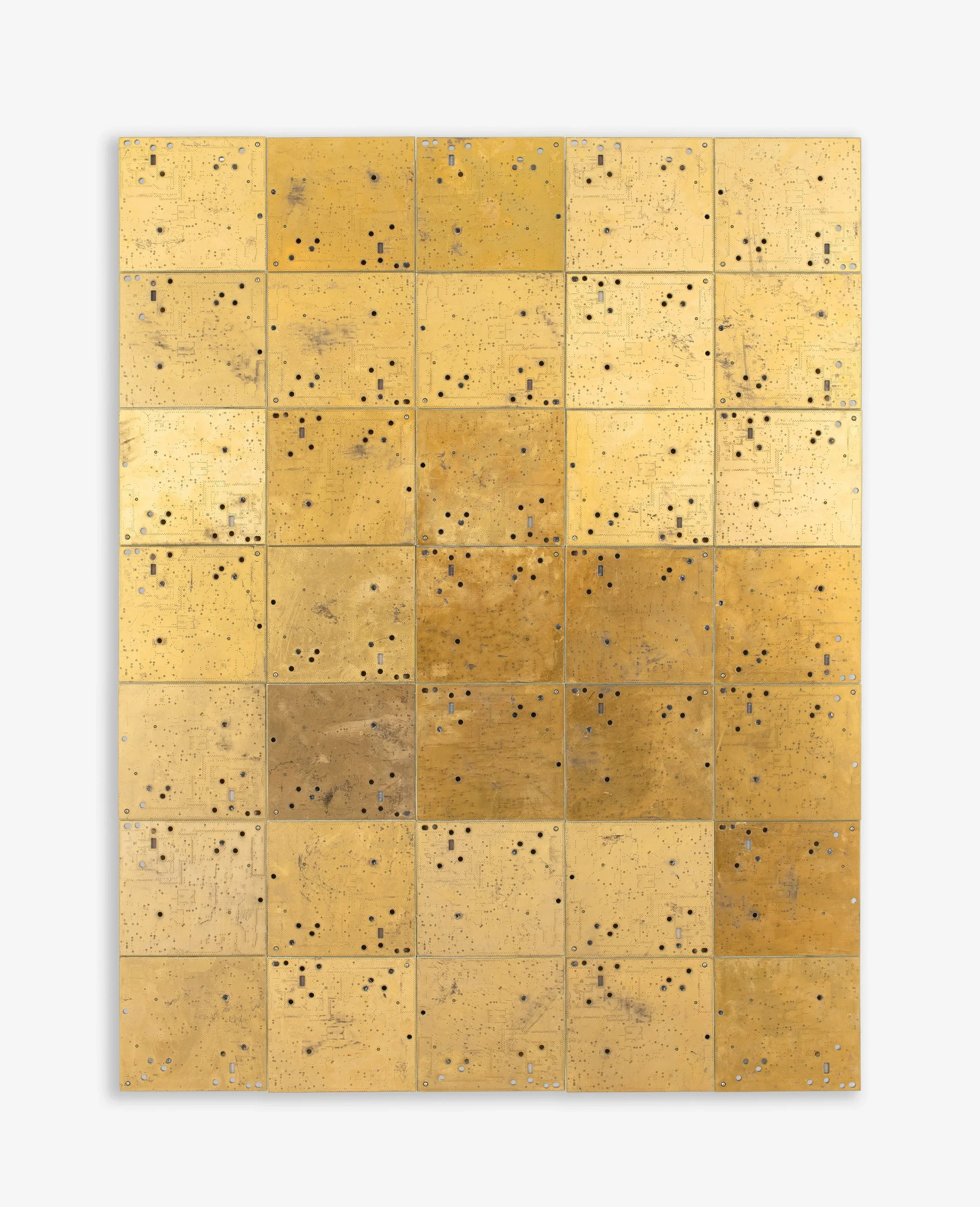
Tan Mu: Signal
On view
5 September – 15 November 2025
Tan Mu’s ongoing Signal series is a sustained artistic investigation into the invisible architectures of global communication. The series transforms submarine fiber-optic networks into symbolic “digital constellations”—bridging abstraction and representation, emotion and system. The artist reimagines these hidden infrastructures not merely as technical constructs but as vessels of collective memory and human connection. By fusing planetary systems with individual and cultural histories, Signal creates poetic diagrams of connection and rupture, mapping time, scale, and collective presence.
As part of a longterm collaboration between Tan Mu and BEK Forum on Signal, the exhibition features five paintings from the series, which depict the undersea telecommunication cables that connect and compose our global, techno-human society. This body of work, grounded in Tan Mu’s oil painting technique and diving experience, creates original, milestone imagery that reflects our evolving relationship with both technology and one another.
Having entered top international collections since its debut at Art Basel Miami Beach 2024, the Signal series will have its first comprehensive presentation, accompanied by music and scholarly programs.
Programs
Inspired by the spatio-temporal dimensions of Tan Mu’s Signal series, the music performance “Everything on the Line” imaginatively reads the paintings as graphic notation. Dots of urban hubs and lines of submarine cables resemble celestial bodies and constellations to conjoin the ocean and the sky. The canvases may evoke the ancient Greek geometric harmony, the Chinese cosmology embodied in Qin, or for a modern audience, the chance composition of John Cage. The authorship of these scores, though, lies as much with the painter and the musicians as with a dynamic world deeply shaped by submarine cables and other forms of technological infrastructure. The lines on the canvas are transformed into musical phrasings that transcend the physical distance between the artwork and the viewer.
The performance also attempts to create a multisensory experience full of nuances between the abstract and the mimetic, the durational and the two-dimensional. If one finds comfort of serenity and perpetuity in Tan Mu’s paintings, the performance gives a picture of what lurks beneath. The tangible lines on the string instruments turn into abstract sounds and vibrations. Each sound created on a single string resembles the fragility inherent in every connection in our human and natural world - everything on the line.
Sophie Steiner and Chatori Shimizu
2 September
Catalogue
Exhibition catalogue for Tan Mu: Signal, featuring essays by Nick Koenigsknecht, Li Yizhuo, and Sophie Steiner.
Limited editions are available, each with a unique drawing by Tan Mu.
Read online.
Signal: Submarine Networks 04 (Norway), 2025
Oil and acrylic on linen
152.5 x 183 cm (60 x 72 in)
Signal 04 (Norway) centers on the dense distribution of submarine cable systems along the Norwegian coast, embedding the region within the data corridors of the North and Baltic Seas. As a northern gateway, Norway anchors the infrastructural frontier of emerging Arctic pathways. Reaching toward Denmark, Sweden, Finland, Estonia, and beyond, the cables outline the shoreline through loops and junctions that extend seaward.
Signal 04 (Norway), 2025 (detail)
Signal: Submarine Networks 05 (UK), 2025
Oil and acrylic on linen
152.5 x 183 cm (60 x 72 in)
Signal 05 (UK) traces the web of submarine cables that ring the British Isles, crossing the North Sea, the English Channel, and the Irish Sea to link Britain and Ireland with continental Europe and the North Atlantic. Dense clusters of landings along the coasts of England and Scotland mark the system’s complexity and reach. Along these unseen seabed lines, traffic moves between Atlantic routes and European networks, forming a critical layer of contemporary communications.

Signal: Submarine Networks 06 (Caribbean Sea), 2025
Oil and acrylic on linen
152.5 x 183 cm (60 x 72 in)
Signal 06 (Caribbean Sea) presents the mesh of submarine cables threading the Caribbean, linking the Bahamas, Cuba, Jamaica, Haiti, the Dominican Republic, Puerto Rico, and many smaller islands into a shared communications basin. Long a maritime stage for empire, piracy, and the transoceanic trade in sugar, rum, and spices—commodities bound to histories of violence and extraction—the region’s routes now carry data. Formerly sea-separated islands are folded into the global circulation of information, recasting an old geography of connection for the digital age.
Signal 06 (Caribbean Sea), 2025 (detail)
Signal: Submarine Networks 07 (Australia), 2025
Oil and acrylic on linen
152.5 x 183 cm (60 x 72 in)
Signal 07 (Australia) displays the sweep of submarine cables across the South Pacific, running along Australia’s eastern coast and outward to New Zealand, Papua New Guinea, French Polynesia, and scattered Pacific archipelagos—an underwater lattice of long-distance communication. The clustered landings and routes read as stepping stones, waypoints that tie Australia to the Americas and Asia. In a region once navigated by stars and canoes, these ancestral paths of movement are now echoed by fiber-optic lines deep below the surface.
Signal 07 (Australia), 2025 (detail)
Signal: Submarine Networks 08 (Italy), 2025
Oil and acrylic on linen
152.5 x 183 cm (60 x 72 in)
Signal 08 (Italy) traces the convergence of submarine fiber-optic cables—including SEA-ME-WE 4, UniTirreno, and BlueMed—at Sicily, Malta, and southern Italy. Extending to and from Africa, the Middle East, and southern Europe, these unseen routes reshape the Mediterranean from a historical trade hub into a vital corridor for global data. Tan Mu reimagines this technical geography as a field of digital constellations: the Tyrrhenian Sea becomes a starry surface that reveals the hidden architecture of today’s information networks.

Beyond the Signal
Alongside the five paintings from the Signal series, this group of additional works invites viewers into a wider atmosphere of thought and connotation. Together, they offer a broader context for understanding Tan Mu’s practice, which moves through themes of connection, transmission, perception, and presence.
Many of these works focus on moments when technology and human consciousness meet. In Share, a newborn rests in her father's arms, recalling the first digital photo ever shared via a mobile device. The painting quietly evokes the threshold of a new era, when the digital transmission of intimacy began to reshape how we relate. Eruption captures the moment a volcanic blast in Tonga severed communication lines, offering both a literal and symbolic image of rupture. In To Mars to Explore, a Mars rover appears to turn its camera back on itself, suggesting a pivotal moment of machine self-awareness, and raising questions about the edges of consciousness and the future of perception.
Other paintings shift the scale of inquiry toward the cosmic and the elemental. Torus evokes the self-sustaining energy system found throughout nature, from black holes to magnetic fields. The painting’s luminous center pulls us into a cycle of continuous movement, a loop of return. Observable Infinity imagines the universe gazing back at us, inviting a quiet reflection on our place within vast and hidden structures while in Moldavite and Antimony, Tan Mu turns her attention to the afterlives of cosmic events, rendering celestial minerals as carriers of memory and transformation. These works feel almost devotional, honoring the invisible connections between matter, time, and meaning.
Peek revisits the first photograph of Earth taken from space, a grainy glimpse that marked the beginning of a new kind of planetary awareness. Mapping, made from found circuit boards, resembles a star chart or satellite view, hinting at the poetic potential of signal, pattern, and logic embedded in our technological tools.
Share (2021) marks a pivotal moment in visual culture: the first instantly shared mobile photograph. A newborn rests in her father’s arms, quietly announcing her arrival to the world. The image echoes Philippe Kahn’s improvisation in June 1997, when, waiting for his daughter’s birth, he wired a digital camera to his mobile phone and a laptop script, creating a makeshift mobile photo-sharing system. The picture was relayed within minutes to over two thousand recipients, years before camera phones and social platforms became ubiquitous. Share honors both a personal milestone and a technological breakthrough that reshaped how we capture and circulate our lives.
Share, 2021
Oil on linen
46 x 61 cm (18 x 24 in)
Eruption, 2022
Oil on linen
76 x 61 cm (30 x 24 in)
Eruption (2022) responds to the explosive events at Hunga Tonga–Hunga Haʻapai, a submarine volcano in the South Pacific. After renewed activity in late December 2021, the eruption culminated on 15 January 2022 in a massive blast recorded by instruments and satellites. Shock waves and ash disrupted regional infrastructure, severing undersea cables and temporarily isolating Tonga; the international link was restored on 22 February—about five weeks later. The interruption underscored the fragility of global connectivity. Created as service returned, Tan Mu’s painting centers a rising cloud that shrouds the archipelago. Two crossing lines suggest an overhead readout—part instrument trace, part satellite view—mirroring how the event reached most audiences through screens. The work considers how technology mediates catastrophe, and what “connection” and “disconnection” mean in a world bound by hidden lines.
To Mars to Explore, 2022
Oil on linen
91 x 102 cm (36 x 40 in)
To Mars to Explore (2022) marks the start of Tan Mu’s Mars series, prompted by a “self-portrait” captured by NASA’s rover Curiosity on the floor of Gale Crater. In February 2022, Curiosity’s Mast Camera (Mastcam) took an image of the rover itself on the Martian surface and sent the photo back to Earth. The camera’s gaze turning back on the machine reads as a contemporary paradox: a tool that appears to see itself. Tan Mu treats the moment as a meditation on perception and agency—how instruments extend human vision and how, in return, we project selfhood onto the devices that explore on our behalf, delving into the essence of existence in a world where the boundaries between humans and machines are increasingly intertwined.
Torus, 2021
Oil on linen
61 x 46 cm (24 x 18 in)
The torus appears across natural and engineered systems—as paired vortices in flows and as toroidal field geometries. As a vortex ring, flow circulates through the core and around the ring in a continuous loop, symbolizing interconnectedness. Familiar instances include smoke rings and whirlpools, doughnut-shaped magnetic fields and tokamaks used in fusion research. In Torus (2021), a transparent, spherical lens seems to hold swirls of light around a pulsing center, set against an etherlike black. The image balances expansion and containment, inviting a reading of energy in circulation across various realms—cosmic, biological, or technological.
Gaze: Observable Infinity, 2024
Oil on linen
36 x 61 cm (14 x 24 in)
Observable Infinity (2024) turns the idea of the “observable universe” into an immersive optic. At its center, a radiant, circular light—part eye, part halo—glows within concentric rings that recede into darkness, marking what can be seen and what withdraws from view. Symbolic color and pared abstraction guide the viewer toward a meditative register, where macrocosm and the personal converge. Light seems to well up from the unknown, carrying information through time toward disclosure. Blending scientific imagination, spirituality, and shared memory, the painting asks how perception organizes experience—and how we belong to a larger, interconnected whole.
Moldavite, 2020
Oil on linen
36 x 28 cm (14 x 11 in)
Moldavite (2020) draws on the motions of celestial bodies and the forces that shape them. Around 15 million years ago, a meteorite impact in what is now southern Germany (the Nördlinger Ries) produced Moldavite (Czech: vltavín), a rare, translucent green tektite. Formed from fused terrestrial material propelled by an extraterrestrial strike, the stone bears the trace of collision and deep time. In Tan Mu’s painting, a dark background accentuates the vivid greens and filigreed textures at center—fingerprint-like whorls that echo the distinctive surfaces of tektites, fragments that carry a record of cosmic events across geologic time. Contemplating this immensity, Moldavite becomes a quiet measure of scale, linking human presence to the vast cosmos.
Antimony, 2020
Oil on linen
40.6 x 50.8 cm (16 x 20 in)
Antimony (2020) draws on the element’s alloy of myth and science. In his alchemical work, Isaac Newton experimented with the regulus of antimony (regulus antimonii)—a bright metallic “button” produced in the furnace, sometimes yielding the star regulus with radiating crystal patterns. (Here regulus is the old metallurgical term, not a reference to the star.) Cosmically, antimony originates in stellar nucleosynthesis before being folded into new systems and, eventually, Earth. While Newton’s alchemy did not yield direct breakthroughs, historians have argued that it informed aspects of his thinking about forces acting at a distance. Today, antimony remains integral to technology, from semiconductor compounds to hardening alloys and flame-retardant formulations. Against a black background, Tan Mu isolates the element’s radiance: from cosmic birth to chemical refinement, from physical properties to technological application, Antimony renders an elemental beauty with lasting technological consequences.
Peek, 2021
Oil on linen
91 x 102 cm (36 x 40 in)
Peek (2021) reimagines the first photographs of Earth taken from space. On 24 October 1946, a captured V-2 rocket (No. 13) launched from White Sands, New Mexico, reaching about 65 miles (105 km). A 35 mm camera aboard exposed frames every 1.5 seconds, returning a sequence that, for the first time, set our planet against the dark field of space. Peek pays homage to that image and marks the beginning of Tan Mu’s Horizons series—an exploration of Earth seen from beyond the atmosphere.
Horizons 03 (2024) looks to the International Space Station for a transformed vantage on Earth. City lights and atmospheric bands become the work’s luminous grammar, suggesting how technology reshapes the way we apprehend landscape at planetary scale. Tan Mu explores the potential of technology to expand visual boundaries, particularly through real-time transmissions from space that allow humanity to observe Earth from a cosmic vantage point. Through layered oil on linen, Tan Mu translates this orbital perspective into color and form: subtle shifts in tone evoke dawn and dusk, the slow seam between sea and sky. The series proposes a widened, collective gaze in which the horizon is not a limit but a conduit for imagining our place together.
Horizons 03, 2024
Oil on linen
46 x 61 cm (18 x 24 in)
Mapping, 2021
Circuit board mounted on wood panel
63.5 x 49.5 cm (25 x 19.5 in)
A circuit board serves as the architectural framework of a computer’s working mind, mechanically supporting and interconnecting components so on-off signals can execute logic. Each hole and engraving on a board carries its own significance. In Mapping (2021), a collection of thirty-five found circuit boards is reimagined as an operational map spliced together. Arranged to evoke an astronomical pattern, the sculptural landscape recalls a night sky filled with stars. Displaced from function, the markings coalesce into abstract constellations. Through this assemblage, the work reflects on the logic of digitization while offering a cosmographic image shaped by chance and recombination.
Like most of Tan Mu’s works, at first glance these additional works do not relate directly to the Signal series, but open us to deeper questions. How do we reach one another, across distance and time? What lives inside the act of transmission? In different ways, each painting listens for a reply, offering us not an answer but a kind of attention... a sense of being held within a wider, almost intangible field. When first encountering Tan Mu’s work, we are tempted to ask “what is our relationship with technology”? However as we explore the work deeper, we must question the very premise of the externality of technology with respects to humanity. While observing technology, are we not looking at ourselves? Therefore perhaps these works function more as self portraits, rather than depictions of external, scientific milestones.
Tan Mu (b. 1991, Shandong, China; lives and works in the United States) is a contemporary artist whose practice investigates the invisible structures that shape modern life—ranging from submarine communication systems and data flows to cosmic observation and memory systems. Her work constructs a visual language that bridges structure and emotion across both macro and micro scales, emphasizing the themes of connection and continuity that underscore our shared human experience.
Combining traditional oil painting with tools of expanded vision— including microscopes, satellite imagery, and scientific visualization— Tan Mu navigates the liminal space between technological history and personal experience. She views technology as both an extension of the body and an externalization of memory, creating compositions that interweave embryos, neurons, logic circuits, quantum computers, solar farms, data nodes, and celestial bodies. Through this layered imagery, she builds visual bridges between the visible and the invisible, the tactile and the abstract, the systemic and the affective.
Tan Mu holds a BFA in Expanded Media from Alfred University, New York (2015), and graduated from the High School of the Central Academy of Fine Arts, Beijing (2011). Her work has been exhibited internationally, with solo exhibitions at Peres Projects (Berlin and Milan, 2022). She has participated in group shows at Arario Gallery, Shanghai, CN (2025); Penske Projects, New York; Winter Street Gallery, Martha’s Vineyard (2024); YveYANG, New York (2023). Her work has been featured and critically reviewed internationally, engaging themes of technology, memory, and visual abstraction across platforms such as Artnet News, Mousse Magazine, and Numéro Berlin. Her paintings are part of private and institutional collections internationally, including the A.R.M. Holding Art Collection (United Arab Emirates), the Carmen Thyssen-Bornemisza Collection (Spain), and the Institute for Electronic Arts (United States).

























